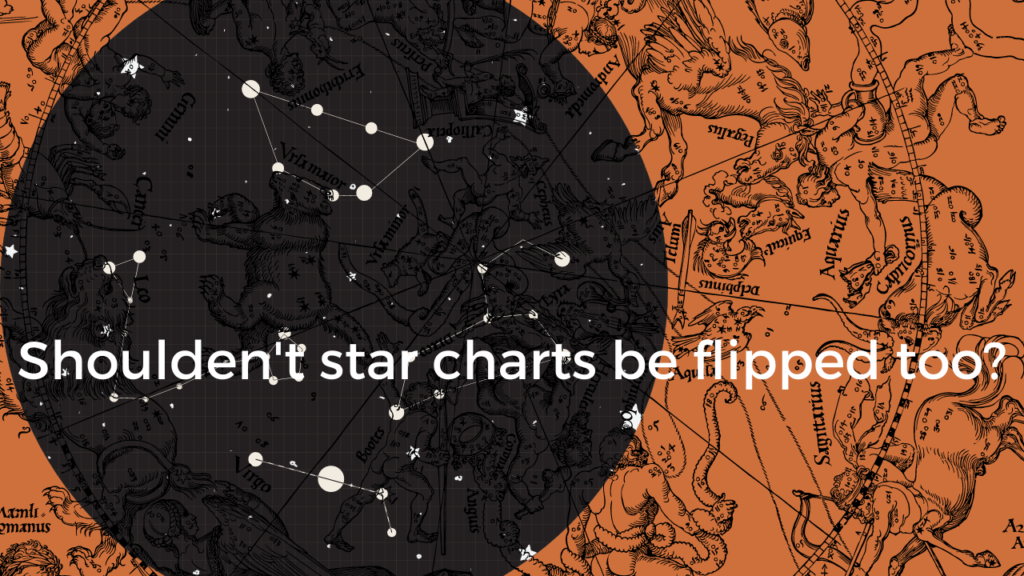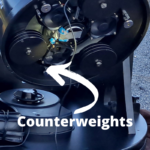Telescopes are made of mirrors and lenses that are designed to collect as much light as possible. In order to gather as much light as possible telescopes often do not add extra glass to correct the image.
Use an erecting prism or erecting eyepiece with your telescope to flip the image. These mirrors or prisms will flip the image, but they will also collect or reflect some light and cause the targets you are viewing to be dimmer. Many refractor telescopes come equipped with a diagonal that will correct the image. Newtonian telescopes will require an erecting eyepiece, which will narrow the field of view.
Images in your telescope may appear flipped upside down and mirrored right to left. This is because telescopes are not designed for terrestrial viewing. They are designed to look at the sky where upside down does not matter too much.
Most astronomers do not find correcting to be necessary. We live on a globe in space and the shape and position of celestial objects will change based on your position on the globe. The concept of upside down is not as important as it would be on earth.
Binoculars and spotting scopes, which are designed to be used when observing things on earth, are corrected to make images appear right side up and not mirrored! This is accomplished by the use of a correcting lens.
You need an odd number of mirrors or lenses, not an even number. In astronomy the trade off is not worth it.
Our eyes need light to be able to see, things you are looking at on earth are MUCH brighter than the objects in the sky, so losing light to a correcting lens on earth will not make a noticeable difference.
Types of Image Correctors
There are several telescope accessories that can be used to flip the image in your telescope if you would like to correct the image.
You may want to correct the image if you are going to use your telescope for terrestrial viewing, or if you are just very bothered by the upside down image.
Diagonal
A diagonal is the most common image corrector. They are used with refracting telescopes where the focuser is on the back of the telescope.

Diagonals use a mirror or prism to flip the image right side up and mirror left to right. These types of image correctors will not work on Newtonian telescopes because they require a lot of back focus.
Erect Image Prism
Erect image Prisms are another type of image corrector that works with refractor telescopes. These look just like a diagonal, but the triangle is replaced by a sphere that contains a prism. The prism reflects the light so that the image appears correct to the observer.
45 Degree Erect Image Prism
45 degree diagonals are the same as right angle diagonals, but they allow observing at a more comfortable angle when observing terrestrial objects.
If you are trying to use a telescope as a spotting scope, try using a 45 degree diagonal.
Erect Image Eyepiece
Newtonian reflectors, telescopes where the eyepiece is on the side not the back, will need to use an erect image eyepiece. These eyepieces contain a prism that bounces the light around and produces a flipped image.
These eyepieces require a very long focal length as they have a long shoulder and they impact the field of view.
These eyepieces will significantly reduce the field of view and are probably not practical for astronomical viewing, but it does allow your Newtonian to work for terrestrial viewing.
Amici Prism
The highest quality erecting prism is an Amici prism. They can be housed in 90 or 45 degree diagonals. They may also have the sphere shaped housing.
Amici prisms are created when two triangular prisms are used in contact. They are typically two types of prisms made of different types of glass.
Change of Position
You can see a perfectly corrected image in a Newtonian telescope without any accessories if you move your eyepiece to be perpendicular to the ground and look through the eyepiece with your chin pointed at your target.
Your target will be fully corrected, but it is a very uncomfortable position. It is more of a party trick than an actual useful technique.
What About Star Charts?
So when we were writing this article the question we had was:
If telescope images are flipped upside down and backwards, are star charts upside down?
A star chart is a map of the sky as it appears to the naked eye. This is the most practical and helpful way to print a star chart.
If you are trying to locate objects you need to see their position as it appears to your eye, when you have located the objects and you view it in your telescope, just that hole punch of the sky will be flipped.
If you are trying to find two objects that are in the same field of view, you need to remember the mirrored and flipped nature of your image, but for most star hopping you will forget that your image is flipped.

Which telescopes show an upside down image?
Most telescopes produce an upside down image, the only exception that I was able to find was a Nasmyth-Coudé, a very specialized type of Cassegrain telescope that has three mirrors, even that scope has the image flipped left to right.
| Telescope | Upside Down? | How To Correct |
| Refracting | Yes | Diagonal |
| Schmidt Cassegrain | Yes | Diagonal |
| Newtonian | Yes | Erecting Eyepiece |
| Dobsonian Telescope | Yes | Erecting Eyepiece or Posture Change |
All telescopes can be corrected for terrestrial viewing, but do you want to?
Each piece of optical glass absorbs or reflects some light. Usually around 3%, which is not very notable when observing bright objects on earth, but when you are hoping to see a faint nebulosity, you will want every photon possible.
Remember, it is not necessary to correct the image in your telescope.
When objects are observed from Earth, they will look different depending on where you are in relation to the object.
The idea of ‘00right side up’ and ‘upside down’ is most important with terrestrial observing.
Are Telescopes Supposed to Be Upside Down?
Telescope images are designed to be upside down in most cases, but there are some exceptions. Each mirror or lens in a telescope reduces the amount of light that enters the eye when using a telescope, so telescopes prioritize keeping as much light as possible, so they often do not add a mirror or lens to flip the image, as it is unnecessary.
Some telescopes have a right angle erector or erecting prism focuser. This is an attachment on the back of refractor telescopes.
For an image to be right side up it needs to have an odd number of mirrors or lenses, but many telescopes only use two mirrors or lenses. Left and right and up and down are much less important in space.
Instruments that are designed for use on Earth, during the day, like binoculars or spotting scopes add the additional lens to flip things. There is plenty of light when observing on Earth, so it does not noticeably degrade the image.





